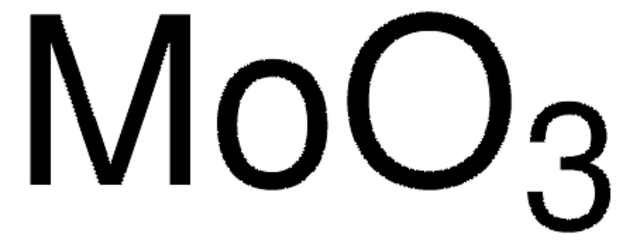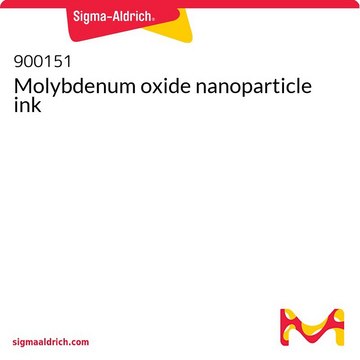M0753
Molybdenum(VI) oxide
ReagentPlus®, ≥99.5%
Synonym(s):
Molybdenum trioxide
Sign Into View Organizational & Contract Pricing
All Photos(3)
About This Item
Linear Formula:
MoO3
CAS Number:
Molecular Weight:
143.94
EC Number:
MDL number:
UNSPSC Code:
12352303
PubChem Substance ID:
NACRES:
NA.55
Assay:
≥99.5%
form:
crystals
Recommended Products
Quality Level
product line
ReagentPlus®
Assay
≥99.5%
form
crystals
reaction suitability
reagent type: catalyst
core: molybdenum
mp
795 °C (lit.)
cation traces
NH4+: ≤0.02%
SMILES string
O=[Mo](=O)=O
InChI
1S/Mo.3O
InChI key
JKQOBWVOAYFWKG-UHFFFAOYSA-N
Looking for similar products? Visit Product Comparison Guide
Application
Precursor to LAMOX fast ion conductors and superconductors.
Used in the solid state synthesis of a remarkable ternary, reduced molybdenum oxide, Pr4Mo9O18, whose structure contains previously unknown Mo7, Mo13 and Mo19 clusters. The new cluster product is a small band gap semiconductor.
Legal Information
ReagentPlus is a registered trademark of Merck KGaA, Darmstadt, Germany
Signal Word
Warning
Hazard Statements
Precautionary Statements
Hazard Classifications
Carc. 2 - Eye Irrit. 2 - STOT SE 3
Target Organs
Respiratory system
Storage Class Code
11 - Combustible Solids
WGK
WGK 1
Flash Point(F)
Not applicable
Flash Point(C)
Not applicable
Choose from one of the most recent versions:
Already Own This Product?
Find documentation for the products that you have recently purchased in the Document Library.
Customers Also Viewed
Patrick R Brown et al.
Nano letters, 11(7), 2955-2961 (2011-06-15)
The ability to engineer interfacial energy offsets in photovoltaic devices is one of the keys to their optimization. Here, we demonstrate that improvements in power conversion efficiency may be attained for ZnO/PbS heterojunction quantum dot photovoltaics through the incorporation of
Seiichiro Murase et al.
Advanced materials (Deerfield Beach, Fla.), 24(18), 2459-2462 (2012-04-11)
An MoO(3) film spin-coated from a solution prepared by an extremely facile and cost-effective synthetic method is introduced as an anode buffer layer of bulk-heterojunction polymer photovoltaic devices. The device efficiency using the MoO(3) anode buffer layer is comparable to
Design of transparent anodes for resonant cavity enhanced light harvesting in organic solar cells.
Nicholas P Sergeant et al.
Advanced materials (Deerfield Beach, Fla.), 24(6), 728-732 (2012-01-04)
Claudio Girotto et al.
ACS applied materials & interfaces, 3(9), 3244-3247 (2011-08-13)
We report on a sol-gel-based technique to fabricate MoO(3) thin films as a hole-injection layer for solution-processed or thermally evaporated organic solar cells. The solution-processed MoO(3) (sMoO(3)) films are demonstrated to have equal performance to hole-injection layers composed of either
Yu-Zhan Wang et al.
The Journal of chemical physics, 134(3), 034706-034706 (2011-01-26)
The electronic structures at the MoO(3)∕Co interface were investigated using synchrotron-based ultraviolet and x-ray photoelectron spectroscopy. It was found that interfacial chemical reactions lead to the reduction of Mo oxidation states and the formation of Co-O bonds. These interfacial chemical
Our team of scientists has experience in all areas of research including Life Science, Material Science, Chemical Synthesis, Chromatography, Analytical and many others.
Contact Technical Service
















